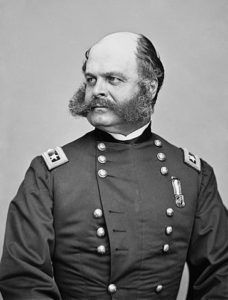Facts and information about Ambrose Burnside, a Civil War General during the American Civil War
Ambrose Burnside Facts
 Born
Born
May 23, 1824 Liberty, Indiana
Died
September 13, 1881 Bristol, Rhode Island
Years Of Service
1847–1865
Rank
Major General
Commands
Army of the Potomac
Army of the Ohio
Battles
American Civil War
First Battle of Bull Run
Burnside’s North Carolina Expedition
Battle of Roanoke Island
Battle of New Bern
Maryland Campaign
Battle of South Mountain
Battle of Antietam
Battle of Fredericksburg
Knoxville Campaign
Overland Campaign
Battle of the Wilderness
Battle of Spotsylvania Court House
Battle of North Anna
Battle of Cold Harbor
Siege of Petersburg
Battle of the Crater
Ambrose Burnside Articles
Explore articles from the HistoryNet archives about Ambrose Burnside
» See all Ambrose Burnside Articles
Ambrose Burnside summary: Ambrose Burnside was the fourth out of nine children born to Pamela and Edghill Brown Burnside and he attended Liberty Seminary when he was only a young boy. His education came to a half after his mother passed away in 1841. Eventually he got an appointment to attend the United States Military Academy where he graduated from in 1847. He served during the Mexican-American War and the Civil War. Burnside served in the Rhode Island Militia as a brigadier general. He was eventually appointed to serve as its colonel in 1861.
Ambrose Burnside In The Civil War
He commanded his brigade at the First Battle of Bull Run and took over the command of his troops after Brigadier General David Hunter was wounded. Burnside then commanded the North Carolina expeditionary force or the coast division. Burnside was eventually offered the command of the Army of the Potomac after the Peninsula Campaign in which Major General George B. McClellan failed. Burnside also led the right wing in the Army of the Potomac when the Battle of South Mountain began. He also served in Fredericksburg, East Tennessee, the Crater, and the Overland Campaign. During the Battle of the Crater, Burnside received orders not to use the division of black troops just a few hours before the infantry attack. Black troops had been trained for the mission; without them, Burnside had to use untrained troops instead.
Ambrose Burnside After The War
Burnside worked at several industrial and railroad directorships after the war including the Martinsville Railroad, Vincennes and Indianapolis Railroad. As of 1874, he became one of the Rhode Island senators, eventually being reelected in 1880. He could not serve his full second term because he died in 1881.
